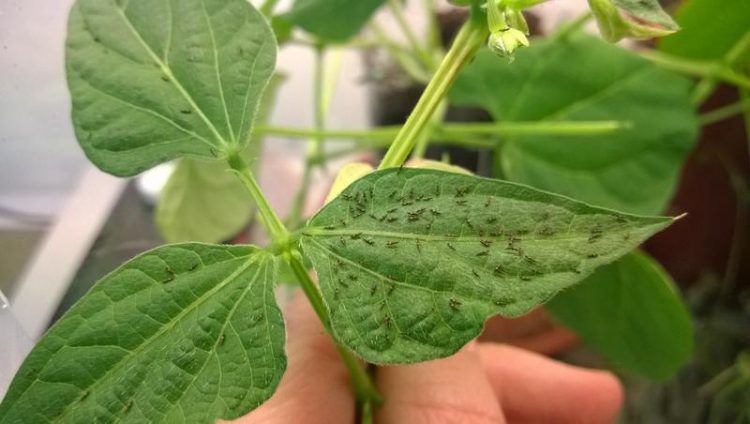Size matters: Biologists at the University of Halle are studying how thrips choose their partners

A plant with thrips Stephanie Krüger
“Larger males have better chances of procreating than their smaller rivals,” says Dr Stephanie Krüger, the study’s lead author. The researcher works alongside Dr Gerald Moritz, a professor of biology from Halle who has been studying thrips for many years. Krüger has investigated a species of thrips called Echinothrips americanus which is only 1.3 millimetres in size.
This species is a pest insect that came to Europe from the USA at the end of the 20th century and is now a common occupant of Germany’s greenhouses. These small insects, which belong to the order Thysanoptera, shouldn’t be underestimated as the damage they cause to the agriculture industry and the horticulture sector can run into the millions.
There are many reasons why the larger males have a higher reproduction success rate. “For one thing, strong males drive off their smaller rivals. Their size also allows them to more easily mount females when mating,” says Krüger.
Added to this is the fact that females from many different species of insect prefer larger males as they promise a higher probability of survival for the eggs and offspring. Furthermore, the animals produce more secretions, which females use as nutrients during egg production. There is even a benefit to male fertility: they produce more sperm.
Until recently little had been scientifically known about the reproductive biology of thrips. The biologists from Halle were able to refute, for example, the wide-spread hypothesis that so-called sternal glands impact mating success. The actual purpose of these glands, located on the insect’s abdomen, remains unclear. Krüger has a hypothesis, and further research should allow her to determine whether male thrips guard the pupae with the intention of being the first to mate with the hatched females.
“We presume that the males mark the territory they are guarding,” says Krüger. If they have a larger pore plate, and consequently more sternal glands, they have an advantage over other males by being able to demarcate their territory. The biologist would also like to analyse whether the females actively seek out their mates or whether the larger males are more successful in finding a copulation partner due to their higher levels of aggression.
The research division “Development Biology” at MLU, led by Professor Gerald Moritz, has been studying thrips for many years. More than 6,100 species belong to their order. These micro-insects, with their stinging and sucking mouthparts, have caused a great deal of resentment in the agriculture industry. They infest cut flowers and damage fruit and vegetables by boring into the plant cells and extracting cell sap.
For instance, they have diminished harvest yields of strawberries in the USA and Germany. In addition, several species transmit major plant viruses. Thrips are also a nuisance in the living rooms of plant lovers throughout the country. Their sucking leaves behind an optically displeasing, silver-grey discoloration on indoor plants like the rubber plant and palms.
Publication:
Krueger, S., Jilge, M., Mound, L., G. Moritz J Insect Behav (2017) 30: 409. doi: 10.1007/s10905-017-9627-z
Media Contact
More Information:
http://www.uni-halle.deAll latest news from the category: Life Sciences and Chemistry
Articles and reports from the Life Sciences and chemistry area deal with applied and basic research into modern biology, chemistry and human medicine.
Valuable information can be found on a range of life sciences fields including bacteriology, biochemistry, bionics, bioinformatics, biophysics, biotechnology, genetics, geobotany, human biology, marine biology, microbiology, molecular biology, cellular biology, zoology, bioinorganic chemistry, microchemistry and environmental chemistry.
Newest articles

Superradiant atoms could push the boundaries of how precisely time can be measured
Superradiant atoms can help us measure time more precisely than ever. In a new study, researchers from the University of Copenhagen present a new method for measuring the time interval,…

Ion thermoelectric conversion devices for near room temperature
The electrode sheet of the thermoelectric device consists of ionic hydrogel, which is sandwiched between the electrodes to form, and the Prussian blue on the electrode undergoes a redox reaction…

Zap Energy achieves 37-million-degree temperatures in a compact device
New publication reports record electron temperatures for a small-scale, sheared-flow-stabilized Z-pinch fusion device. In the nine decades since humans first produced fusion reactions, only a few fusion technologies have demonstrated…





















